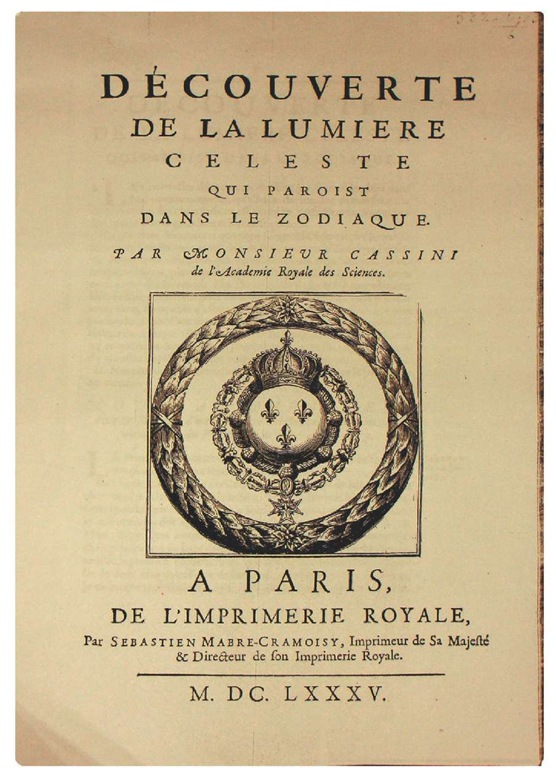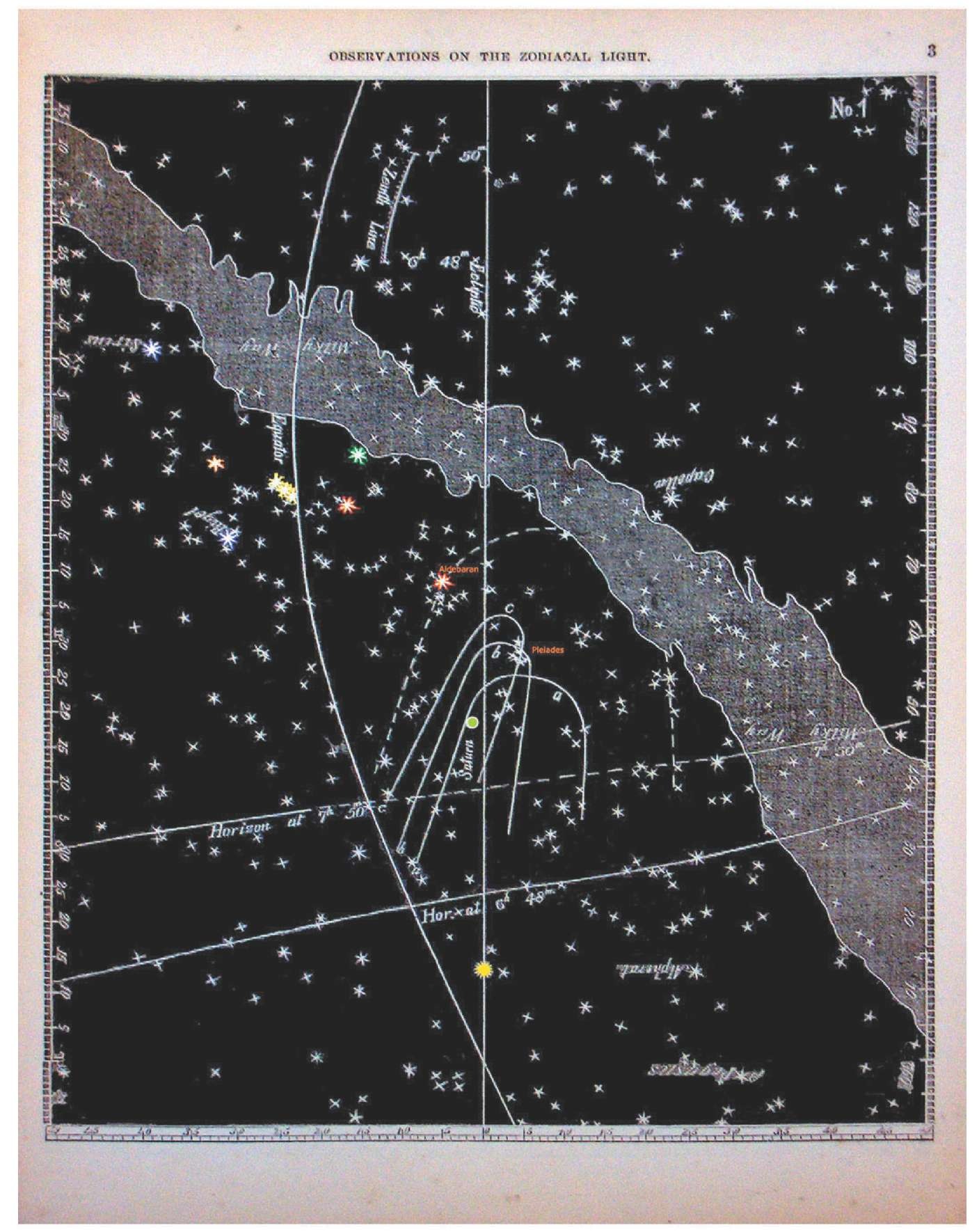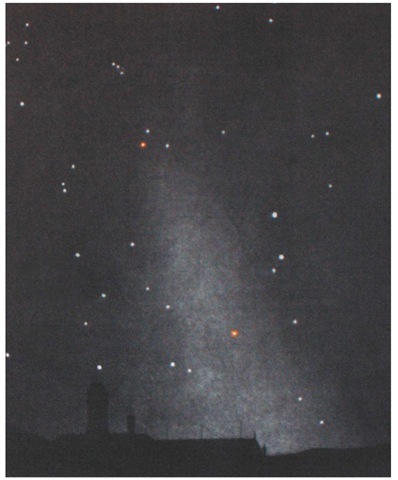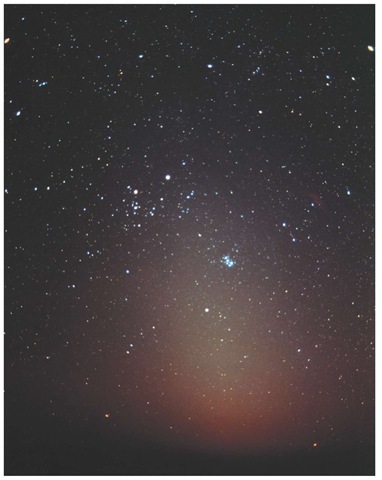The Zodiacal Light, conveniently abbreviated to ‘ZL’, is the name given to a diffuse cone of light seen in the Western sky in the evening, from around the end of twilight, and in the Eastern morning sky just before dawn. In the latter incarnation it has been called the ‘False Dawn’. If it could be viewed in a completely dark sky when the Sun was eclipsed, we might imagine that the complete outline of a brightness contour of the ZL would be an ellipse, with the Sun at its centre, and its long axis roughly aligned with the ecliptic. To see this phenomenon clearly on Earth, it is necessary to have a good, dark sky, free from clouds, terrestrial light sources, moonlight, or aurorae. It is also an advantage to be within or near the tropics, since it is here that the cone of light is inclined at a high angle to the horizon, making it still visible when the Sun is well below the horizon, and the sky is completely dark. The maximum intensity of the ZL is greater than the brightest parts of the Milky Way, and in ideal conditions, the morning and evening cones are seen to be linked up, by a continuous faint band right around the ecliptic. This ‘Zodiacal Band’ is visible all through the night, and shows a secondary brightening at the anti-solar point, known as the "Gegenschein". With modern instruments more sensitive than the human eye, it has become apparent that even well off the ecliptic, indeed even at the ecliptic pole, there is still some contribution to the sky background brightness from this phenomenon. The Zodiacal Light, in fact, surrounds us.
A knowledge of the nature and distribution of the material responsible for the ZL is interesting for many reasons. At the time when I began this research, around 1970, manned space flight was just beginning, and there was a need to evaluate what dangers to astronauts there might be from high-energy micrometeorites. In studies of the origin of our Solar System, too, there are benefits in knowing the composition and motions of the interplanetary dust; the present parameters of this cloud of material can give indications as to how our planetary system was formed, and how the Sun’s environment is evolving at present. In the 21st Century, studies of the ZL have become relevant for new reasons; dozens of exo-planets in other solar systems are now known to us in 2007, but as early as 1984 in the IRAS experiment, the "Vega Phenomenon" was discovered (see discussion by Beichman 1987) – infrared excesses in radiation indicating clouds of solid grains around three nearby Main Sequence stars, Alpha Lyrae (Vega) (Aumann et al 1984), Alpha Piscis Austrinus (Fomalhaut), and Beta Pictoris. Many other discoveries followed, and it now appears that these exo-circum-stellar dust clouds – the Zodiacal aggregations of other suns – are very common features of the environs of stars. The most studied of the exo-zodiacal clouds is perhaps fi Pictoris (Smith, Terile 1984), whose dust debris disc, viewed conveniently edge-on from Earth, appears to be concentrated in more than one plane, perhaps indicating disturbance from yet undetected planets (Hubble website 2006). A thorough knowledge of our own evolving system of planets, debris and dust helps to shed light on the evolution of planetary systems in general. Of course the search is highlighted by a desire to answer the question of whether our Earth, and life as we know it, is unique in Creation, or if such life is scattered liberally throughout the Universe. Zodiacal Dust may still be holding on to some of the secrets relating to these questions.
Review of observations of the ZL prior to 1970
Earliest views
"If I take the wings of the morning, and dwell in the uttermost parts of the sea, even there shall thy hand lead me, and thy right hand shall hold me" – Psalms 39, vv. 9-10.
This biblical quotation has been mooted (Fechtig et al 2004) as a possible reference to the appearance of the morning ZL, but other translations give the verse a different meaning: the ‘Word of God’ translation has it as "If I climb upward on the rays of the morning Sun, or land on the most distant shore of the sea where the Sun sets …" Moreover it is common for wings to be poetically ascribed to the Sun and Moon, and also to the Morning itself, which may be the case here.Are there any other signs of ancient knowledge of the ZL? Fechtig et al (2004) allow that the Aztecs (16th Century) may be correctly credited with having noticed the ZL, and that there are possible references from the Chaldeans (600 B.C.) and the ancient Egyptians, but such occasional mentions are few indeed compared with the liberal scattering of allusions in art of all kinds to other heavenly manifestations (for example, the works of Shakespeare contain a virtual catalogue of atmospheric phenomena!).
Figure 1.1 Cassini’s paper of 1685, claiming the discovery of the Zodiacal Light.
The great exception seems to be Omar Khayyam, the great astronomer-poet of Persia. In his Rubaiyat (circa 1120), there are two passages highly evocative of the ZL:
"Awake! For Morning in the Bowl of Night
Has flung the Stone that puts the Stars to Flight" and …
"When False Dawn streaks the East with cold, gray line Pour in your cups the pure Blood of the Vine The Truth, they say, tastes bitter in the mouth, This is a token that the "Truth" is wine."
In the West, the scientific ‘discovery’ of the ZL is attributed to Giovanni Domenico Cassini, the famous French astronomer, who, in his publications of 1683 and 1685 (see Figure 1.1) claims the find.
Certainly he was the first to quantify it, chart it in the celestial sphere, and, with great insight, suggest an explanation for the phenomenon. But 22 years earlier, J. Childrey (1661) had already brought the ZL to the attention of the Western world. In his work, "Britannica Baconica, or the Natural Rarities of England, Scotland, and Whales (sic)" he wrote, "In February you shall see a plainly discernible way of the twilight striking up towards to the Pleiades … and I believe it… will be constantly visible at that time of the year. But what the cause of it in Nature should be I cannot yet imagine but leave it to further enquiry". This is the classic view of the evening Zodiacal Light, and to this day, February – March remains the perfect time of year to see it in the Northern Hemisphere. Cassini and his student Niccolo Fatio de Duillers went a long way towards ‘explaining’ the appearance of the Zodiacal Light – even suggesting dust particles in orbit around the Sun as the source. But the fact that these men were the first to document the extent of this quite spectacular manifestation in the Heavens is in itself curious.
It is remarkable that so few earlier records are available, since, unless a sudden dramatic increase in brightness occurred in the seventeenth century, the mysterious Light of the Zodiac ought to have been very conspicuous in the dark skies of earlier civilisations, comparable in dimensions with the Milky Way, and at its brightest, more luminous. The number of people living in the modern world who will ever see the Zodiacal Light must be dwindling fast, as urbanisation spreads with its accompanying light pollution, but in ancient times the unpolluted night skies familiar to shepherds and sailors ought to have yielded at least a frequent mention of this ghostly cone of light; and why not a whole folklore, such as pertains to the Milky Way, especially since much of the ancient civilised world resided in or near the tropics? The very fact that there is no popular layman’s name in any language for what scientists now call the Zodiacal Light suggests that there is an anomaly here. Could it be that our view of the Zodiacal Light is highly variable? Cassini was convinced that it disappeared completely between 1665 and 1681, and this man was certainly no casual observer. I have no solution to the puzzle. In the light of Cassini’s reports, along with Jones’s observations detailed below, and the curious dearth of references pre-Cassini, I am convinced that, despite the lack of any recent confirmation, we must admit the possibility that the Zodiacal Light has not always been what it is today. One other early set of observations of the ZL is worthy of special mention.
On April 2nd 1853, the Rev. George Jones (1856), Chaplain of the United States Navy, set off on a nautical voyage to Japan and back, and made visual observations of the Zodiacal Light every night, evening and morning, for the whole duration of the trip, a period of over two years. Jones was meticulous in his documentation of the appearance of the phenomenon, and made efforts to eliminate subjectivity from his findings by seeking corroboration from his companions on the ship, who had no prior expectations of what they were supposed to see.
Figure 1.2 A chart from "Observations on the Zodiacal Light from April 2, 1853, to April 22, 1855, made chiefly on board the United States Steam-Frigate Mississippi, during her late cruise in Eastern Seas, and her voyage homeward: with conclusions from the data.
The discovery of the Gegenschein, or counter-glow, is generally attributed to Brorsen, (1854) who first observed it in this year, but he himself acknowledged that Humboldt had named it in 1803, and it is documented that Esprit Peneza reported its existence to the Paris Academy in 1731. It is interesting to note that Jones did not know of the existence of the Gegenschein until he returned home, but had rejected the observation as unreliable – because he thought it should not be there – and only then did he realise that he had seen it one night. This is a reminder that, even in such a careful and unbiased observer, the tendency is to see what one expects to see, and not see what is not expected. I will have cause to revisit this idea later. Perhaps we can call it the "Lucky Find Syndrome" (LFS, for short, of course!). By 1854, early photography was well under way, but, although scientists of the day (including Piazzi Smyth) had successfully secured images of many astronomical subjects, the sensitised plates of the day, Daguerreotype, Albumen, and Wet Plate Collodion, did not yet possess the sensitivity needed to record an image of the ZL. Hence we only have artistic impressions to go on from this period. A fine engraving of its appearance in 1856, published by Muller in 1865 (see Fechtig et al 2004), is reproduced here (Figure 1.3a). The Hyades are shown at top left of the picture, and it will be seen that there are two interlopers to the star scene … two planets, right on the line of the ecliptic (I have coloured them orange), reminding us that the axis of the ZL does indeed lie (roughly) in the ecliptic plane.
Here the Zodiacal cone ‘strikes up’ towards the Pleiades and Hyades, visible at top left, of the picture, just as in Childrey’s description. For comparison, Figure 1.3b (overleaf) shows a photographic view, taken about 150 years later. Although the constellation of Taurus is slightly lower in this view, again the Pleiades and Hyades feature, in a strikingly similar configuration of the Spring ZL, viewed from the Northern Hemisphere. Again, a bright planet is featured.
In all ground-based photographs of the ZL that I have seen, atmospheric extinction modifies the actual recorded shape from a cone to something closer to an ellipse, but this never appears in drawings; it seems that the naked-eye observer instinctively compensates for the effect of darkening at the horizon (and reddening, as seen here).
1856 was also the year in which the celebrated Scottish astronomer Charles Piazzi Smyth (1856) published an account of his expedition to Tenerife, to perform site-testing at high altitudes, the intention being to confirm the theory, first proposed by Newton, that the quality of ‘seeing’ would improve at high altitudes.
Figure 1.3a The Zodiacal Light as seen on March 5, 1856, over the city of Friebourg in Breisgau, stretching up to the Pleiades.
Figure 1.3b The evening Zodiacal Light.
Smyth, one of the first scientists to apply himself to studies of the ZL, suggested that its spectrum must be essentially reflected sunlight, and in Tenerife in 1855 he made the first attempts to confirm this spectroscopically. Over a hundred years later, spectroscopy would be used successfully to map radial velocity patterns relative to the Earth in the Zodiacal Dust Cloud, and I’m sure Piazzi would have been happy to know that this too was to take place in his beloved Tenerife.
Evidence as to the scattering medium
Anders Jonas Angstrom, one of the fathers of spectroscopy, discovered the fundamental relationship between absorption lines and emission lines, was the first to find evidence of Hydrogen in the spectrum of the Sun, and gave his name to the Angstrom Unit (10-10 m). In 1867 he recorded (incorrectly, it turns out) that he had found the same blue-green emission line in the spectrum of the Zodiacal Light as he had previously (correctly) found in the Aurora Borealis. Since then, it has been substantially confirmed that there are no emission lines present in the visible portion of the spectrum of the ZL. Emission lines from airglow are always liable to be mixed in with ZL measurements, in any ground-based observation, but are now recognisable as such. Medium resolution spectra of the ‘cones’ (Hoffmeister 1940) showed a continuum with Fraunhofer absorption lines, and Gindilis (1963) found an energy distribution in the Gegenschein the same as sunlight, so it may be regarded as established that the ZL shines by sunlight reflected (or more correctly, scattered) by a relatively slow-moving medium. If electrons were present in the Zodiacal Cloud, due to their high speeds, they would add a highly ‘Doppler-smeared’ component to the scattered spectrum, filling in the absorption lines. This effect was shown to be absent by Blackwell and Ingham (1961), who, by measuring the depth of Fraunhofer lines, placed an upper limit of 120/ cm3 on electron density at 1 AU, so the ZL material must be almost exclusively dust. In the light of later ZC models, perhaps this conclusion is now in doubt, since models with orbits that are elliptical, rather than circular, also show shallower absorption lines, and some observers have now claimed to have confirmed this observationally (Madsen et al 2006 – see topic 4). The composition of the dust was variously estimated to be ‘irons’ and ‘stones’ (predominantly silicates), similar to meteorites found on Earth, or graphites, (as some exo-planets are now believed to be), or a mixture of ices (solid carbon dioxide, ammonia, water, etc.), though these would have short lifetimes within a few Astronomical Units from the Sun. The shapes of particles actually collected were, and are, predominantly irregular, or ‘fluffy’, though a few approximate better to the smooth spheres almost invariably used (Hemenway 1967) in early theoretical models!
Measurable quantities in ZL observations
Measurements of the Zodiacal Light available to various observers up to the 1970′s may be summarised according to type as follows:
a) Photometry - Measurements are made of the intensity of the ZL as a function of angular distance (‘elongation’) from the Sun, and distance from the axis, across the ‘cone’. This information can provide pointers to the physical parameters of the cloud, discriminating between theoretical models of particle size and distribution (see, for example, Smith et al 1965). Measurements of colour, again as a function of elongation from the Sun, have provided clues to particle sizes (e.g. Elvey 1934). Notably, Carlos Sanchez Magro of the University of La Laguna in Tenerife (PhD Thesis 1974), in a seven-year study, found a dependence of Zodiacal Light brightness on solar activity.
b) Polarisation - Measurements are made of the polarisation of the ZL, usually as a function of elongation from the Sun, an indicator of particle sizes and properties (e.g. Sanchez 1969).
c) Solar Corona measurements - The outer regions of the Solar Corona, so stunningly visible at times of total solar eclipse, merge into the inner parts of the ZL, so measurements on the Corona can be relevant (Beavers et al 1980).
d) Position of the axis of the ZL - measurements are made of the angle the axis makes with the ecliptic and its points of intersection. The aim is to ascertain which plane the dust principally lies in, and if its distribution is symmetrical about this plane, and symmetrical East to West. A dependence of the axis position on the latitude of the observer would indicate a GDC component (Geocentric Dust Cloud) – in other words, that a significant proportion of the dust was located near the Earth, rather than in orbits around the Sun. Thus these measurements can enable us to inform an opinion about where the dust lies (e.g. Huruhata, Masaaki 1965). Wolstencroft et al (1967) concluded that no GDC component had been detected.
e) Absorption line strength measurement - the spectrum of the Zodiacal Light (sunlight reflected from moving particles) is compared with that of the Sun. The lessening in spectral line strength was believed to indicate a proportion of particles with high velocities ‘smearing ‘ the scattered spectrum (Blackwell and Ingham 1961).
f) Space-borne detection and collection of particles - samples are collected from space vehicles, from the Moon, from deep sea sediments, from permafrost in Antarctica, and from the Stratosphere (see section 1.4.3).
g) Emission (black body) spectra - the warm Zodiacal dust emits radiation in the infrared. This can be detected by ground-based observations, but only through the available atmospheric ‘windows’. But this line of enquiry is much easier from a vantage point in space, where there is no restriction on the wavelengths which can be studied. This kind of observation came of age much later, with the IRAS satellite and others (see 1.4.2).
h) Radial velocity measurements - the speed and direction of the motions of dust are inferred from Doppler shifts in the absorption lines in the scattered solar spectrum. This is the line of inquiry pursued in this research project, again principally as a function of elongation from the Sun. Ground-based spectroscopy of the Zodiacal Light, such as that described in this thesis, is well-known to be difficult: there are appreciable challenges to meet – among them, extremely low light levels, atmospheric extinction, airglow, and light pollution from solar and lunar twilight. It would clearly be very attractive to mount a corresponding experiment in space, where these problems would not occur; however, on the ground, experiments can be conducted over a long time period, and much data accumulated.
i) Shapes of Spectral Lines - Clarke et al (1995) computed actual profiles due to integrations of Doppler shifts, and were able to predict a bifurcation of minima at elongations close to the Sun. As it becomes possible to observe at higher spectral resolutions, much more could be done in this area.




